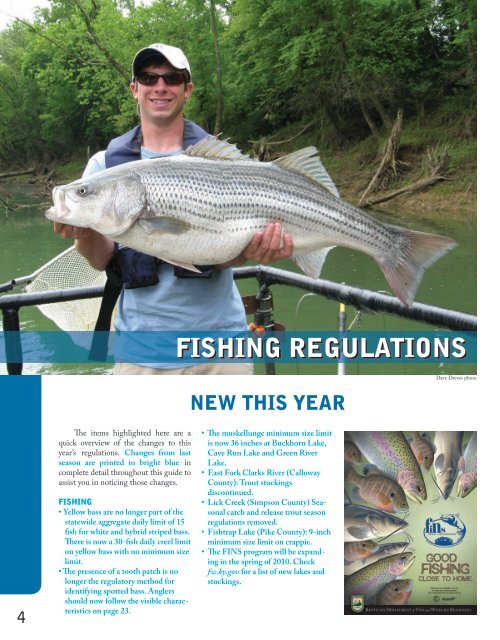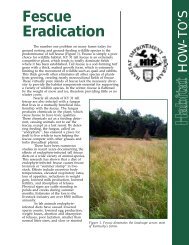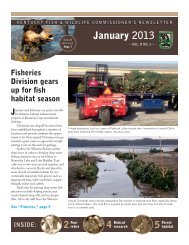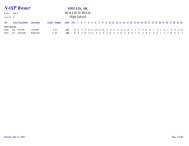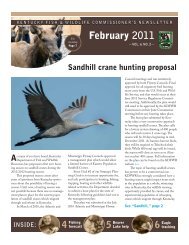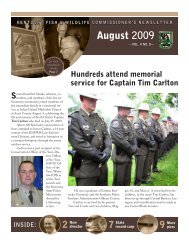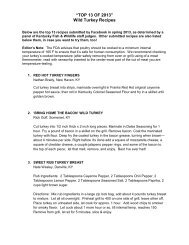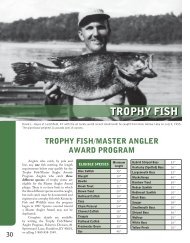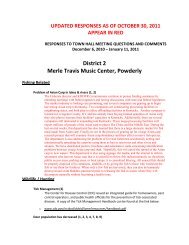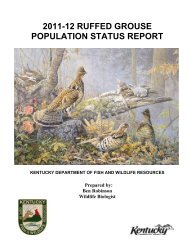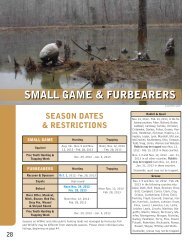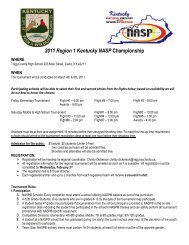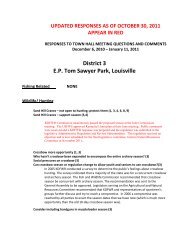Fishing Regulations - Kentucky Department of Fish and Wildlife ...
Fishing Regulations - Kentucky Department of Fish and Wildlife ...
Fishing Regulations - Kentucky Department of Fish and Wildlife ...
Create successful ePaper yourself
Turn your PDF publications into a flip-book with our unique Google optimized e-Paper software.
FISHING REGULATIONS<br />
The items highlighted here are a<br />
quick overview <strong>of</strong> the changes to this<br />
year’s regulations. Changes from last<br />
season are printed in bright blue in<br />
complete detail throughout this guide to<br />
assist you in noticing those changes.<br />
FISHING<br />
• Yellow bass are no longer part <strong>of</strong> the<br />
statewide aggregate daily limit <strong>of</strong> 15<br />
fish for white <strong>and</strong> hybrid striped bass.<br />
There is now a 30-fish daily creel limit<br />
on yellow bass with no minimum size<br />
limit.<br />
• The presence <strong>of</strong> a tooth patch is no<br />
longer the regulatory method for<br />
identifying spotted bass. Anglers<br />
should now follow the visible characteristics<br />
on page 23.<br />
FISHING REGULATIONS<br />
NEW THIS YEAR<br />
• The muskellunge minimum size limit<br />
is now 36 inches at Buckhorn Lake,<br />
Cave Run Lake <strong>and</strong> Green River<br />
Lake.<br />
• East Fork Clarks River (Calloway<br />
County): Trout stockings<br />
discontinued.<br />
• Lick Creek (Simpson County) Seasonal<br />
catch <strong>and</strong> release trout season<br />
regulations removed.<br />
• <strong>Fish</strong>trap Lake (Pike County): 9-inch<br />
minimum size limit on crappie.<br />
• The FINS program will be exp<strong>and</strong>ing<br />
in the spring <strong>of</strong> 2010. Check<br />
fw.ky.gov for a list <strong>of</strong> new lakes <strong>and</strong><br />
stockings.<br />
Dave Dreves photo
BLACK BASS<br />
STATEWIDE REGULATIONS<br />
Some waterbodies have different size <strong>and</strong> creel limits, please refer to the “Special <strong><strong>Fish</strong>ing</strong> <strong>Regulations</strong>” section for more details.<br />
SPORT FISH SPECIES Daily Limit Possession Limit Minimum Size Limit<br />
Largemouth Bass 6* 12* 12”<br />
Smallmouth Bass 6* 12* 12”<br />
<strong>Kentucky</strong> (Spotted) Bass 6* 12* none<br />
Coosa Bass 6* 12* none<br />
Rock Bass 15 30 none<br />
Redear Sunfish 20 40 none<br />
Walleye, sauger <strong>and</strong> their hybrids 6* 12*<br />
15” on walleye <strong>and</strong><br />
hybrids; none on sauger<br />
Muskellunge 1 2 30”<br />
Chain Pickerel 5 10 none<br />
Northern Pike none none none<br />
White & hybrid striped bass 15** 30** none**<br />
Striped bass 5 10 15”<br />
Yellow bass 30 60 none<br />
Crappie (black & white) 30* 60* none<br />
Rainbow trout<br />
none<br />
Daily limit 8, only 3 may be brown trout***<br />
Brown trout 12”<br />
Brook trout Catch <strong>and</strong> release only<br />
* Singly or combined; a total <strong>of</strong> these species<br />
** No more than 5 fish in the daily creel limit may be more than 15 inches long.<br />
*** Possession limit is double the daily creel limit for these species.<br />
<strong>Fish</strong> not included in this list are considered rough fish. There are no size or creel limits for rough fish, unless special regulations apply.<br />
For daily creel <strong>and</strong> fishing license purposes, one fishing day equals one calendar day.<br />
STATEWIDE SIZE AND CREEL<br />
LIMITS (301 KAR 1:060, 1:201; KRS<br />
150.010)<br />
<strong><strong>Fish</strong>ing</strong> season is open year-round<br />
in <strong>Kentucky</strong>, except on waterfowl refuges<br />
<strong>and</strong> as otherwise noted in this guide.<br />
Statewide size <strong>and</strong> creel limits apply to<br />
all <strong>Kentucky</strong> waters, public <strong>and</strong> private,<br />
except some waters have different limits<br />
(see, “Special <strong><strong>Fish</strong>ing</strong> <strong>Regulations</strong>”.) The<br />
<strong>Kentucky</strong> Trout Waters information is<br />
now incorporated into this guide. Please<br />
see page 26.<br />
Ask first!<br />
Always ASK FIRST before entering privately owned l<strong>and</strong>.<br />
Q: How is a daily creel limit<br />
different than a possession limit?<br />
A: The daily creel limit is the<br />
number <strong>of</strong> a particular sport fish<br />
species you may keep in one day’s<br />
fishing. A possession limit is two<br />
times the daily creel limit for all fish<br />
species with a daily creel limit <strong>and</strong><br />
excludes processed fish.<br />
MEASURING FISH<br />
(301 KAR 1:201)<br />
Measure all fish from the tip <strong>of</strong> the<br />
lower jaw (closed) to the tip <strong>of</strong> the tail<br />
with fish laid flat on rule with tail lobes<br />
squeezed together. Undersized fish must<br />
be returned immediately to the waters<br />
from which they were taken in the best<br />
possible physical condition.<br />
length<br />
Squeezed tail<br />
FISHING REGULATIONS
FISHING REGULATIONS<br />
BULLFROGS<br />
(301 KAR 1:082)<br />
The taking season for bullfrogs<br />
opens at noon on the third Friday in<br />
May (May 21, 2010) <strong>and</strong> runs through<br />
Oct. 31. If a gun or bow <strong>and</strong> arrow are<br />
used, a hunting license is required. If<br />
frogs are taken by pole <strong>and</strong> line, a fishing<br />
license is required. If frogs are taken<br />
by gig or by h<strong>and</strong>, then either hunting or<br />
fishing license is valid. The daily noonto-noon<br />
creel limit for bullfrogs is 15.<br />
The possession limit is 30.<br />
TURTLES<br />
(301 KAR 1:058)<br />
Anglers may take snapping turtles<br />
(except alligator snapping turtles) <strong>and</strong><br />
s<strong>of</strong>tshell turtles year round by the same<br />
methods legal for taking rough fish species.<br />
Commercial fishing gear may not<br />
be used to take turtles. A hunting license<br />
is required when taking turtles by gun or<br />
by bow <strong>and</strong> arrow. Otherwise a fishing<br />
license is required.<br />
Turtle traps may be one <strong>of</strong> two<br />
kinds: either a barrel or drum with a tilting<br />
trigger board or a floating log raft<br />
with an enclosed twine or wire mesh<br />
bag. Turtle traps must be inspected daily.<br />
All turtles must be removed daily except<br />
one decoy turtle may remain. Any other<br />
species (except s<strong>of</strong>t shelled <strong>and</strong> snapping<br />
turtles) caught in a turtle trap must be<br />
released unharmed.<br />
GRASS CARP HARVEST<br />
PROHIBITED<br />
(301 KAR 1:201)<br />
Harvesting grass carp is prohibited<br />
in any lake owned or managed by<br />
KNOW YOUR TURTLES!<br />
COMMON SNAPPING TURTLE<br />
Legal to take<br />
OTHER SPECIES<br />
the <strong>Kentucky</strong> <strong>Department</strong> <strong>of</strong> <strong>Fish</strong> <strong>and</strong><br />
<strong>Wildlife</strong> Resources. Anglers who catch a<br />
grass carp from one <strong>of</strong> these lakes must<br />
immediately return the fish to the water<br />
where it was caught. Grass carp are used<br />
to control aquatic vegetation. Signs are<br />
posted at applicable lakes.<br />
LIVE BAIT FOR PERSONAL USE<br />
(301 KAR 1:130, 1:122)<br />
No live fish, live bait fish or live<br />
bait organisms that are not native or<br />
established in <strong>Kentucky</strong> waters shall be<br />
bought, sold, possessed, imported, or in<br />
any way used or released into waters <strong>of</strong><br />
this Commonwealth. Blueback herring<br />
are not native to <strong>Kentucky</strong> <strong>and</strong> may not<br />
be imported or possessed in this state.<br />
Holders <strong>of</strong> sport fishing licenses<br />
may take live bait from public waters<br />
<strong>and</strong> may possess up to 500 minnows, 500<br />
crayfish, 25 spring lizards or dusky salam<strong>and</strong>ers,<br />
5 frogs (other than bullfrogs),<br />
100 tadpoles, 100 native lampreys, 500<br />
other aquatic invertebrate organisms<br />
other than mussels, 500 shad (except on<br />
lakes where shad possession/use is prohibited),<br />
500 herring <strong>and</strong> any number <strong>of</strong><br />
unshelled Asiatic clams. A commercial<br />
license is required to take live bait from<br />
public waters open to commercial fishing<br />
for the purpose <strong>of</strong> selling.<br />
Regardless <strong>of</strong> size or how obtained,<br />
it is illegal to use any sport fish for bait<br />
(except redear sunfish). (Sport fish species<br />
listed on page 5). Minnows are defined<br />
as all fish, except sport fish species,<br />
less than 6 inches long. Also, see page 24<br />
for a description <strong>of</strong> fish species protected<br />
in <strong>Kentucky</strong> under the Endangered<br />
Species Act – these fish species shall not<br />
be taken for any use. Bluegills are not<br />
sport fish <strong>and</strong> may be taken for bait as<br />
described above.<br />
Live bait may be taken with the following<br />
gear:<br />
• Dip Nets: Maximum size <strong>of</strong> 3 feet in<br />
diameter is legal in the Ohio, Tennessee<br />
<strong>and</strong> Mississippi rivers, Cumberl<strong>and</strong><br />
River below Barkley Dam, <strong>Kentucky</strong><br />
River below Lock No. 14, <strong>and</strong> all lakes<br />
having 1,000 or more surface acres.<br />
• Minnow Traps: Maximum legal size<br />
statewide: 3 feet long, 18 inches in diameter,<br />
1-inch openings for catching.<br />
• Seines: Maximum legal size statewide:<br />
10 feet long, 4 feet deep, ¼-inch mesh.<br />
Maximum legal size in the Ohio <strong>and</strong><br />
Mississippi rivers <strong>and</strong> <strong>Kentucky</strong> <strong>and</strong><br />
Barkley lakes: 30 feet long, 6 feet deep<br />
<strong>and</strong> ¼-inch bar mesh.<br />
• Sport Cast Nets: Maximum sport cast<br />
net size is 20 feet in diameter with<br />
maximum 1-inch bar mesh statewide<br />
except in the following waters. Sport<br />
cast nets prohibited in: 1) lakes having<br />
fewer than 500 surface acres, 2) any <strong>of</strong><br />
the streams <strong>and</strong> tailwaters listed in the<br />
“Trout Waters” section <strong>of</strong> this guide,<br />
3) tributaries <strong>of</strong> the Cumberl<strong>and</strong> River<br />
between Wolf Creek Dam <strong>and</strong> the<br />
Tennessee state line except Crocus <strong>and</strong><br />
Marrowbone creeks where sport cast<br />
mesh size must be made <strong>of</strong> 1-inch bar<br />
mesh only, 4) from the mouth <strong>of</strong> Crocus<br />
Creek upstream for 50 yards.<br />
All sport fish incidentally taken<br />
while capturing live bait with seines, dip<br />
nets or cast nets must be released immediately<br />
unharmed into the water.<br />
ALLIGATOR SNAPPING TURTLE<br />
Illegal to take
SPECIAL FISHING REGULATIONS<br />
(301 KAR 1:080, 1:180, 1:201, 2:222<br />
4:100, 4:200E; KRS 150.010, 150.025)<br />
SPECIAL REGULATION WATERS<br />
LISTED ALPHABETICALLY<br />
The public waters listed below have<br />
different size <strong>and</strong>/or creel limits than<br />
statewide regulations allow. Statewide<br />
size <strong>and</strong> creel limits apply unless otherwise<br />
mentioned below. Special boating<br />
regulations are listed in the Boating section<br />
<strong>of</strong> this guide.<br />
Some privately owned waters may<br />
have special size <strong>and</strong> creel limits as posted<br />
by signs.<br />
Ask first!<br />
Always ASK FIRST before entering<br />
privately owned l<strong>and</strong>.<br />
BARK CAMP CREEK<br />
Whitley County<br />
All trout caught from October 1<br />
through March 31 must be immediately<br />
released <strong>and</strong> only artificial baits shall be<br />
used during this period.<br />
BARKLEY, KENTUCKY LAKES<br />
(<strong>and</strong> their connecting canal)<br />
• Crappie: 10-inch minimum size limit,<br />
20 fish daily creel limit.<br />
• Largemouth <strong>and</strong> Smallmouth Bass:<br />
15-inch minimum size limit.<br />
• Sauger: 14-inch minimum size limit.<br />
BARKLEY TAILWATER – See<br />
Cumberl<strong>and</strong> River<br />
BARREN RIVER LAKE<br />
The boundaries <strong>of</strong> Barren River<br />
Lake are from the dam upstream to the<br />
Hwy. 100 bridge, Long Creek to the<br />
Hwy. 100 bridge, Beaver Creek to the<br />
Hwy. 1297 bridge, Skaggs Creek to the<br />
Matthews Mill Road bridge <strong>and</strong> Peter<br />
Creek to the Peter Creek Road bridge.<br />
• Crappie: 9-inch minimum size limit.<br />
• Largemouth <strong>and</strong> Smallmouth Bass:<br />
15-inch minimum size limit except 1<br />
fish in the daily creel limit or 2 in the<br />
possession limit may be less than 15<br />
inches long.<br />
BEAVER CREEK<br />
Wayne County<br />
All trout caught from October<br />
1 through March 31 in the section <strong>of</strong><br />
Beaver Creek from the Hwy. 90 bridge<br />
upstream to the Hwy. 200 bridge must<br />
be immediately released. Only artificial<br />
baits shall be used during this period.<br />
BEAVER LAKE<br />
Anderson County<br />
Possession or use <strong>of</strong> shad for bait is<br />
prohibited.<br />
• Largemouth Bass: 15-inch minimum<br />
size limit.<br />
• Channel Catfish: 12-inch minimum<br />
size limit.<br />
BERT COMBS LAKE<br />
Clay County<br />
Possession or use <strong>of</strong> shad for bait is<br />
prohibited.<br />
BESHEAR LAKE<br />
Caldwell County<br />
• Channel Catfish: 12-inch minimum<br />
size limit.<br />
BIG BONE CREEK<br />
Boone County<br />
All trout caught from October 1<br />
through March 31 must be immediately<br />
released <strong>and</strong> only artificial baits shall be<br />
used during this period.<br />
BOLTZ LAKE<br />
Grant County<br />
Possession or use <strong>of</strong> shad for bait is<br />
prohibited.<br />
• Channel Catfish: 12-inch minimum<br />
size limit.<br />
BRIGGS LAKE<br />
Logan County<br />
Possession or use <strong>of</strong> shad for bait is<br />
prohibited.<br />
BUCKHORN LAKE<br />
• Largemouth <strong>and</strong> Smallmouth Bass:<br />
15-inch minimum size limit.<br />
• Muskellunge: 36-inch minimum size<br />
limit.<br />
• Crappie: 9-inch minimum size limit.<br />
BULLOCK PEN LAKE<br />
Grant <strong>and</strong> Boone counties<br />
• Channel Catfish: 12-inch minimum<br />
size limit.<br />
CANE CREEK<br />
Laurel County<br />
All trout caught from October 1<br />
through March 31 must be immediately<br />
released <strong>and</strong> only artificial baits shall be<br />
used during this period.<br />
CARNICO LAKE<br />
Nicholas County<br />
• Largemouth Bass: 15-inch minimum<br />
size limit.<br />
CARPENTER LAKE<br />
Daviess County<br />
Possession or use <strong>of</strong> shad for bait is<br />
prohibited.<br />
CARR CREEK LAKE<br />
• Crappie: 9-inch minimum size limit.<br />
• Largemouth <strong>and</strong> Smallmouth Bass:<br />
15-inch minimum size limit.<br />
CARTER CAVES STATE PARK LAKE<br />
(also called Smokey Valley Lake)<br />
<strong><strong>Fish</strong>ing</strong> during daylight hours only.<br />
Possession or use <strong>of</strong> shad for bait is<br />
prohibited.<br />
• Largemouth Bass: No minimum size<br />
limit, 6 fish daily creel limit.<br />
CASEY CREEK<br />
Trigg County<br />
All trout caught from October 1<br />
through March 31 must be immediately<br />
released <strong>and</strong> only artificial baits shall be<br />
used during this period.<br />
CAVE RUN LAKE<br />
Gigging <strong>and</strong> snagging prohibited<br />
in the main lake <strong>and</strong> all tributaries up<br />
to the first riffle. The location <strong>of</strong> the<br />
first riffle may change depending on<br />
water levels.<br />
• Largemouth Bass: 13 to 16-inch protective<br />
slot limit. All largemouth bass<br />
between 13 <strong>and</strong> 16 inches in length<br />
<strong>Fish</strong> propagation<br />
It is unlawful to use public waters<br />
for the private or commercial<br />
propagation <strong>of</strong> fish.<br />
FISHING REGULATIONS
FISHING REGULATIONS<br />
must be released immediately.<br />
• Smallmouth Bass: 18-inch minimum<br />
size limit.<br />
• Muskellunge: 36-inch minimum size<br />
limit.<br />
CEDAR CREEK LAKE<br />
Lincoln County<br />
Possession or use <strong>of</strong> shad for bait is<br />
prohibited.<br />
• Largemouth Bass: 20-inch minimum<br />
size limit, 1 fish daily creel limit.<br />
• Crappie: 30 fish daily creel limit, no<br />
minimum size limit.<br />
• Channel Catfish: No daily creel limit,<br />
12-inch minimum size limit.<br />
CHIMNEY TOP CREEK<br />
Wolfe County<br />
A 16-inch minimum size limit <strong>and</strong><br />
1 fish daily creel limit for brown trout<br />
<strong>and</strong> only artificial baits may be used.<br />
CLEAR CREEK<br />
Bell County<br />
All trout caught from October 1<br />
through March 31 shall be immediately<br />
released <strong>and</strong> only artificial baits may be<br />
used during this period.<br />
CORINTH LAKE<br />
Grant County<br />
Possession or use <strong>of</strong> shad for bait is<br />
prohibited.<br />
• Channel Catfish: 12-inch minimum<br />
size limit.<br />
CUMBERLAND GAP NATIONAL<br />
HISTORICAL PARK<br />
(301 KAR 1:035)<br />
Special fishing regulations are in effect<br />
on Cumberl<strong>and</strong> Gap National Historical<br />
Park. For complete fishing information<br />
on this area contact: Cumberl<strong>and</strong><br />
Gap National Historical Park, P.O. Box<br />
1848, Middlesboro, KY 40965, phone<br />
(606) 248-2817.<br />
CUMBERLAND RIVER, (including<br />
Hatchery Creek) from Wolf Creek<br />
Dam to the Tennessee state line:<br />
All licensed anglers must possess<br />
a trout permit on this portion <strong>of</strong><br />
Cumberl<strong>and</strong> River. This also includes<br />
Hatchery Creek <strong>and</strong> all tributaries up<br />
to the first riffle.<br />
Anglers shall not cull trout by<br />
replacing a live trout in their possession<br />
with another trout. Once an angler<br />
holds a trout in their possession on this<br />
section <strong>of</strong> the Cumberl<strong>and</strong> River, it<br />
counts toward the daily trout creel<br />
limit. Anglers may not attract or chum<br />
trout with bait, corn or other<br />
attractants designed to draw numbers<br />
<strong>of</strong> trout to a specific area. This<br />
includes all tributaries up to the first<br />
riffle <strong>and</strong> in Hatchery Creek.<br />
• Brown Trout: 20-inch minimum size<br />
limit, 1 fish daily creel limit, also applies<br />
to all tributary streams.<br />
• Rainbow Trout: 15 to 20-inch<br />
protective slot limit. All trout caught<br />
between 15 <strong>and</strong> 20 inches in length<br />
must be immediately released. Five<br />
fish daily creel limit, only one rainbow<br />
trout may be longer than 20 inches.<br />
Also applies to all tributary streams.<br />
Due to variable water quality related<br />
to maintenance <strong>of</strong> Wolf Creek Dam,<br />
the rainbow trout creel limit has<br />
temporarily been raised to 10 fish. All<br />
other trout regulations remain the<br />
same. Anglers should monitor our<br />
webpage (fw.ky.gov) <strong>and</strong> signs posted<br />
at access sites for changes.<br />
Q: May I fish around a dock or<br />
a marina?<br />
A: It depends. Public marinas<br />
on U.S. Army Corps <strong>of</strong> Engineers<br />
Lakes have contractual agreements<br />
that address lease space on public<br />
waters. The Corps presently allows<br />
the marina owners or operators to<br />
post signs that prohibit fishing within<br />
150 feet <strong>of</strong> their floating structures.<br />
These agreements do not prohibit<br />
a person from fishing in their boat<br />
rental slip. This policy does not apply<br />
to privately owned boat docks on<br />
Corps lakes.<br />
CUMBERLAND RIVER from Lake<br />
Barkley Dam downstream to confluence<br />
with Ohio River<br />
Gigging <strong>and</strong> snagging only<br />
permitted downstream <strong>of</strong> U.S. 62<br />
bridge with a daily creel limit <strong>of</strong> 8 fish.<br />
Harvesting <strong>of</strong> sportfish by snagging is<br />
prohibited. Snagging anglers cannot<br />
release or cull any snagged paddlefish.<br />
Snagged paddlefish or their roe cannot<br />
be sold.<br />
• Sauger: 14-inch minimum size limit.<br />
DALE HOLLOW LAKE<br />
• Crappie: 10-inch minimum size limit,<br />
15 fish daily creel limit.<br />
• Black Bass creel: includes largemouth,<br />
smallmouth <strong>and</strong> <strong>Kentucky</strong> (spotted)<br />
bass – 5 fish daily creel limit on black<br />
bass singly or combined, only two <strong>of</strong><br />
which may be smallmouth bass.<br />
• Largemouth Bass: 15-inch minimum<br />
size limit.<br />
• Smallmouth Bass: 16 to 21-inch<br />
protective slot limit. One fish over 21<br />
inches <strong>and</strong> one fish under 16 inches<br />
may be kept daily.<br />
• Sauger: 14-inch minimum size limit,<br />
10 fish daily creel limit.<br />
• Rainbow <strong>and</strong> Lake Trout: April 1-<br />
Oct. 31: no size limit, 7 fish daily<br />
creel limit (only 2 may be lake trout).<br />
Nov. 1 - March 31: 22-inch size limit,<br />
2 fish daily limit, singly or combined.<br />
• Walleye: 16-inch minimum size limit,<br />
5 fish daily creel limit.<br />
DEWEY LAKE<br />
• Largemouth <strong>and</strong> Smallmouth Bass:<br />
15-inch minimum size limit.<br />
DIX RIVER from Herrington Lake<br />
Dam downstream for two miles<br />
<strong><strong>Fish</strong>ing</strong> with artificial lures or flies only.<br />
DOE RUN LAKE<br />
Kenton County<br />
Possession or use <strong>of</strong> shad for bait is<br />
prohibited.<br />
• Largemouth Bass: 15-inch minimum<br />
size limit, 3 fish daily creel limit.<br />
• Channel Catfish: Four fish daily creel<br />
limit, no minimum size limit.<br />
DOG FORK<br />
Wolfe County<br />
Only artificial baits with a single<br />
hook shall be used. Brook Trout must<br />
be immediately released.<br />
EAST FORK INDIAN CREEK<br />
Menifee County<br />
All trout caught from October 1<br />
through March 31 shall be immediately<br />
released <strong>and</strong> only artificial bait shall be<br />
used during this period.<br />
ELKHORN CREEK in Franklin<br />
County from confluence <strong>of</strong> North<br />
<strong>and</strong> South forks downstream to<br />
<strong>Kentucky</strong> River:<br />
• Largemouth <strong>and</strong> Smallmouth Bass:<br />
12 to 16-inch protective slot limit.<br />
Largemouth <strong>and</strong> smallmouth bass<br />
caught between 12 <strong>and</strong> 16 inches in
length must be immediately released.<br />
Daily limit <strong>of</strong> 6 may include no more<br />
than 2 fish longer than 16 inches.<br />
ELK SPRING CREEK<br />
Wayne County<br />
All trout caught from October 1<br />
through March 31 must be immediately<br />
released <strong>and</strong> only artificial baits shall be<br />
used during this period.<br />
ELMER DAVIS LAKE<br />
Owen County<br />
Possession or use <strong>of</strong> shad for bait is<br />
prohibited.<br />
• Largemouth Bass: 12 to 15-inch protective<br />
slot limit. All largemouth bass<br />
between 12 <strong>and</strong> 15 inches in length<br />
must be released immediately.<br />
• Channel Catfish: 12-inch minimum<br />
size limit.<br />
FAGAN BRANCH LAKE (also called<br />
Lebanon City Lake)<br />
Marion County<br />
• Largemouth <strong>and</strong> Smallmouth Bass:<br />
12 to 15-inch protective slot limit.<br />
All largemouth <strong>and</strong> smallmouth bass<br />
between 12 <strong>and</strong> 15 inches in length<br />
must be released immediately.<br />
FISHTRAP LAKE<br />
• Largemouth <strong>and</strong> Smallmouth Bass:<br />
15-inch minimum size limit.<br />
• Crappie: 9-inch minimum size limit.<br />
GENERAL BUTLER STATE PARK<br />
LAKE<br />
Carroll County<br />
Possession or use <strong>of</strong> shad for bait is<br />
prohibited.<br />
• Largemouth Bass: 15-inch minimum<br />
size limit, 3 fish daily creel limit.<br />
• Channel Catfish: 4 fish daily creel<br />
limit, no minimum size limit.<br />
GOLDEN POND (L<strong>and</strong> Between the<br />
Lakes National Recreation Area)<br />
• Channel Catfish: 15-inch minimum<br />
size limit, 5 fish daily creel limit.<br />
GRAYSON LAKE<br />
• Largemouth <strong>and</strong> Smallmouth Bass:<br />
15-inch minimum size limit.<br />
GREENBO LAKE Greenup County<br />
Possession or use <strong>of</strong> shad for bait is<br />
prohibited.<br />
• Bluegill <strong>and</strong> other Sunfish: 15 fish<br />
daily creel limit.<br />
GREEN RIVER LAKE<br />
• Crappie: 9-inch minimum size limit.<br />
• Muskellunge: 36-inch minimum size<br />
limit.<br />
GUIST CREEK LAKE<br />
Shelby County<br />
• Channel Catfish: 12-inch minimum<br />
size limit.<br />
KENTUCKY, BARKLEY LAKES<br />
(<strong>and</strong> their connecting canal)<br />
• Crappie: 10-inch minimum size limit,<br />
20 fish daily creel limit.<br />
• Largemouth <strong>and</strong> Smallmouth Bass:<br />
15-inch minimum size limit.<br />
• Sauger: 14-inch minimum size limit.<br />
KENTUCKY LAKE TAILWATER<br />
– see Tennessee River<br />
KINCAID LAKE<br />
Pendleton County<br />
• Channel Catfish: 12-inch minimum<br />
size limit.<br />
LAND BETWEEN THE LAKES<br />
NATIONAL RECREATION AREA<br />
(301 KAR 1:031)<br />
Special fishing regulations are in<br />
effect for ponds <strong>and</strong> small lakes within<br />
L<strong>and</strong> Between the Lakes National<br />
The Angler’s Legacy program<br />
aims to mobilize the 7.5 million<br />
avid anglers in the United<br />
States to “take someone fishing.”<br />
The program intends to pass the<br />
angling legacy down to the next<br />
generation. Take the pledge by logging<br />
on to www.anglerslegacy.org to<br />
take a child, friend, co-worker or<br />
relative on a fishing trip.<br />
Recreation Area. For complete fishing<br />
information on this area, anglers should<br />
contact: L<strong>and</strong> Between the Lakes National<br />
Recreation Area, Golden Pond,<br />
KY 42231, phone (270) 924-2000.<br />
LAKE BLYTHE<br />
Christian County<br />
• Largemouth Bass: 12 to 15-inch protective<br />
slot limit. All largemouth bass<br />
caught between 12 <strong>and</strong> 15 inches in<br />
length must be immediately released.<br />
LAKE CHUMLEY<br />
Lincoln County<br />
<strong><strong>Fish</strong>ing</strong> during daylight hours only.<br />
LAKE CUMBERLAND<br />
The boundaries <strong>of</strong> Lake Cumberl<strong>and</strong><br />
are defined as Cumberl<strong>and</strong> Falls<br />
on the Cumberl<strong>and</strong> River, Devils Jump<br />
on the Big South Fork, the Narrows <strong>of</strong><br />
Rockcastle River <strong>and</strong> Laurel River Lake<br />
Dam on Laurel River.<br />
• Crappie: 10-inch minimum size limit.<br />
• Largemouth Bass: 15-inch minimum<br />
size limit.<br />
• Smallmouth Bass: 18-inch minimum<br />
size limit.<br />
• Striped Bass: 24-inch minimum size<br />
limit, 2 fish daily creel limit.<br />
LAKE JERICHO<br />
Henry County<br />
Possession or use <strong>of</strong> shad for bait is<br />
prohibited.<br />
• Largemouth Bass: 15-inch minimum<br />
size limit.<br />
LAKE MALONE<br />
• Largemouth Bass: 12 to 15-inch protective<br />
slot limit. All largemouth bass<br />
caught between 12 <strong>and</strong> 15 inches in<br />
length must be immediately released.<br />
• Channel Catfish: 12-inch minimum<br />
size limit.<br />
LAKE MINGO<br />
Jessamine County<br />
• Largemouth Bass: 15-inch minimum<br />
size limit, 3 fish daily creel limit.<br />
• Channel Catfish: 4 fish daily creel<br />
limit, no minimum size limit.<br />
LAKE POLLYWOG<br />
Grant County<br />
• Largemouth Bass: 15-inch minimum<br />
size limit, 3 fish daily creel limit.<br />
• Channel Catfish: 4 fish daily creel<br />
limit, no minimum size limit.<br />
FISHING REGULATIONS
FISHING REGULATIONS<br />
10<br />
LAKE SHELBY<br />
Shelby County<br />
• Largemouth Bass: 15-inch minimum<br />
size limit, 3 fish daily creel limit.<br />
• Channel Catfish: 4 fish daily creel<br />
limit, no minimum size limit.<br />
LAUREL RIVER LAKE<br />
• Largemouth Bass: 15-inch minimum<br />
size limit.<br />
• Smallmouth Bass: 18-inch minimum<br />
size limit, 2 fish daily creel limit.<br />
• Crappie: 9-inch minimum size limit,<br />
15 fish daily limit.<br />
LEARY LAKE<br />
Grant County<br />
<strong><strong>Fish</strong>ing</strong> during daylight hours only.<br />
• Channel Catfish: 4 fish daily creel limit.<br />
• Largemouth Bass: 15-inch minimum<br />
size limit, 3 fish daily creel limit.<br />
LEBANON CITY LAKE – see Fagan<br />
Branch Lake<br />
LEFT FORK, BEAVER CREEK<br />
Floyd County<br />
All trout caught from October 1<br />
through March 31 must be immediately<br />
released <strong>and</strong> only artificial baits shall be<br />
used during this period.<br />
LINCOLN HOMESTEAD STATE<br />
PARK LAKE<br />
Washington County<br />
<strong><strong>Fish</strong>ing</strong> during daylight hours only.<br />
Possession or use <strong>of</strong> shad for bait is<br />
prohibited.<br />
• Channel Catfish: 4 fish daily creel<br />
limit.<br />
• Largemouth Bass: 15-inch minimum<br />
size limit; 3 fish daily creel limit.<br />
MARION COUNTY LAKE<br />
Possession or use <strong>of</strong> shad for bait is<br />
prohibited.<br />
• Largemouth Bass: 15-inch minimum<br />
size limit.<br />
McNEELY LAKE<br />
Jefferson County<br />
Possession or use <strong>of</strong> shad for bait is<br />
prohibited.<br />
MIDDLE FORK, RED RIVER<br />
Powell County<br />
Within the Natural Bridge State<br />
Park, all trout caught from October 1<br />
through March 31 must be immediately<br />
released <strong>and</strong> only artificial baits shall be<br />
used during this period.<br />
MILL CREEK LAKE<br />
Powell <strong>and</strong> Wolfe counties<br />
Possession or use <strong>of</strong> shad for bait is<br />
prohibited.<br />
• Largemouth Bass: 15-inch minimum<br />
size limit; 3 fish daily creel limit.<br />
NEW HAVEN OPTIMIST LAKE<br />
Nelson County<br />
• Largemouth Bass: 15-inch minimum<br />
<strong>Kentucky</strong>’s largest salam<strong>and</strong>er: Eastern Hellbender<br />
-Can grow up<br />
to 24” long<br />
-Completely<br />
aquatic<br />
-Not<br />
aggressive<br />
or poisonous<br />
-Long lived<br />
(up to<br />
30 years)<br />
HAVE YOU<br />
SEEN ME?<br />
<strong>Kentucky</strong> <strong>Fish</strong> <strong>and</strong> <strong>Wildlife</strong> is very interested in all locality records for the<br />
eastern hellbender. If you see this giant salam<strong>and</strong>er, please e-mail John<br />
MacGregor (john.macgregor@ky.gov) or Greg Lipps (greglipps@aol.com) with<br />
locality information <strong>and</strong> a photograph, if possible.<br />
size limit, 3 fish daily creel limit.<br />
• Channel Catfish: 4 fish daily creel<br />
limit, no minimum size limit.<br />
NOLIN RIVER LAKE<br />
Lake upper boundary extended<br />
to the Wheelers Mill Road bridge in<br />
the Nolin River arm <strong>and</strong> to the Hwy.<br />
728 bridge in the Bacon Creek arm<br />
(formerly defined as first riffle upstream<br />
in Bacon Creek <strong>and</strong> Nolin River).<br />
• Crappie: 9-inch minimum size limit.<br />
• Largemouth <strong>and</strong> Smallmouth Bass:<br />
15-inch size limit, except 1 fish in the<br />
daily limit or 2 in the possession limit<br />
may be less than 15 inches long.<br />
OHIO RIVER – see also, “Bordering<br />
Waters” page 15<br />
• Walleye, Sauger <strong>and</strong> their Hybrids:<br />
no minimum size limit, 10 fish daily<br />
limit, singly or combined.<br />
• White Bass, Yellow Bass, Striped<br />
Bass <strong>and</strong> their Hybrids: 30 fish daily<br />
limit, only 4 fish in daily limit may be<br />
15 inches or longer.<br />
OTTER CREEK<br />
Meade County<br />
All trout caught in Fort Knox<br />
Military Reservation <strong>and</strong> in Otter<br />
Creek Park from October 1 through<br />
March 31 must be immediately released<br />
<strong>and</strong> only artificial baits shall be used<br />
during this period. Fort Knox Military<br />
Reservation requires the purchase <strong>of</strong> a<br />
$10 permit to fish <strong>and</strong> is closed to fishing<br />
on Tuesdays. Anglers must check-in<br />
with the Fort Knox Hunt Control Office<br />
at (502) 624-2712 before each day’s<br />
fishing. There is a one-mile section <strong>of</strong><br />
Otter Creek as posted by signs in Fort<br />
Knox Military Reservation where trout<br />
fishing is open to statewide regulations.<br />
PAINT CREEK<br />
Johnson County<br />
16-inch minimum size limit <strong>and</strong><br />
1 fish daily creel limit on trout from<br />
the KY 40 bridge downstream to the<br />
first U.S. 460 bridge crossing <strong>and</strong> only<br />
artificial baits shall be used.<br />
PAINTSVILLE LAKE<br />
• Largemouth Bass: 12 to 15-inch protective<br />
slot limit. All largemouth bass<br />
caught between 12 <strong>and</strong> 15 inches in<br />
length must be released immediately.<br />
• Smallmouth Bass: 18-inch minimum<br />
size limit.
PARCHED CORN CREEK<br />
Wolfe County<br />
Only artificial baits with single<br />
hook shall be used. Brook Trout must<br />
be immediately released.<br />
PEABODY WMA LAKES<br />
In addition to a fishing license, a<br />
$15.00 user permit is required <strong>of</strong> persons<br />
age 16 <strong>and</strong> over while on Peabody<br />
WMA. Permits can be purchased where<br />
fishing licenses are sold. <strong><strong>Fish</strong>ing</strong> open<br />
Mar. 16 - Oct. 14 on Goose, Isl<strong>and</strong><br />
<strong>and</strong> South Lake, all other lakes open<br />
year-round.<br />
PENNYRILE LAKE<br />
Christian County<br />
• Largemouth Bass: 12 to 15-inch protective<br />
slot limit. All largemouth bass<br />
between 12 <strong>and</strong> 15 inches in legnth<br />
must be immediately released.<br />
PIKEVILLE CITY LAKE<br />
Pike County<br />
• Largemouth Bass: All largemouth<br />
bass caught must be immediately<br />
released.<br />
POOR FORK <strong>and</strong> its tributaries<br />
Letcher County<br />
Downstream to the first crossing<br />
<strong>of</strong> Hwy. 932, only artificial baits with<br />
single hook shall be used. Brook Trout<br />
must be immediately released.<br />
REBA LAKE<br />
Madison County<br />
Possession or use <strong>of</strong> shad for bait is<br />
prohibited.<br />
• Largemouth <strong>and</strong> Smallmouth Bass:<br />
15-inch minimum size limit, 3 fish<br />
daily creel limit.<br />
ROCK CREEK<br />
McCreary County<br />
From Bell Farm Bridge upstream<br />
to Tennessee state line, all trout caught<br />
from October 1 through March 31<br />
must be immediately released <strong>and</strong> only<br />
artificial baits shall be used during this<br />
period.<br />
ROUGH RIVER LAKE<br />
• Crappie: 9-inch minimum size limit.<br />
• Largemouth <strong>and</strong> Smallmouth Bass:<br />
15-inch minimum size limit except 1<br />
fish in the daily creel limit or 2 in the<br />
possession limit may be less than 15<br />
inches long.<br />
SHANTY HOLLOW LAKE<br />
Warren County<br />
Possession or use <strong>of</strong> shad for bait is<br />
prohibited.<br />
• Largemouth Bass: 15-inch minimum<br />
size limit.<br />
• Channel Catfish: 12-inch minimum<br />
size limit.<br />
SHILLALAH CREEK<br />
Bell County<br />
Outside the Cumberl<strong>and</strong> Gap<br />
National Park as posted, only artificial<br />
baits with single hook shall be used.<br />
Brook Trout must be immediately<br />
released.<br />
SPORTSMAN’S LAKES<br />
Franklin County<br />
<strong><strong>Fish</strong>ing</strong> during daylight hours only.<br />
Possession or use <strong>of</strong> shad for bait is<br />
prohibited.<br />
• Channel Catfish: 4 fish daily creel<br />
limit.<br />
• Largemouth <strong>and</strong> Smallmouth Bass:<br />
15-inch minimum size limit, 3 fish<br />
daily creel limit.<br />
SPURLINGTON LAKE<br />
Taylor County<br />
Possession or use <strong>of</strong> shad for bait is<br />
prohibited.<br />
SWIFT CAMP CREEK<br />
Clifty Wilderness, Wolfe County<br />
All trout caught from October 1<br />
through May 31 shall be released immediately<br />
<strong>and</strong> only artificial baits shall<br />
be used during this period.<br />
SYMPSON LAKE<br />
Nelson County<br />
• Largemouth Bass: 15-inch minimum<br />
size limit.<br />
TAYLORSVILLE LAKE<br />
Lake upper boundary extended to<br />
Dry Dock Road on Salt River (formerly<br />
defined as first riffle upstream in Salt<br />
River).<br />
• Crappie: 9-inch minimum size limit,<br />
15 fish daily creel limit.<br />
• Largemouth <strong>and</strong> Smallmouth Bass:<br />
15-inch minimum size limit.<br />
TAYLORSVILLE LAKE WMA<br />
PONDS<br />
• Largemouth Bass: 15-inch minimum<br />
size limit; 3 fish daily creel limit.<br />
• Channel Catfish: 4 fish daily creel limit.<br />
TENNESSEE RIVER from <strong>Kentucky</strong><br />
Lake Dam downstream to<br />
confluence with Ohio River<br />
The area from <strong>Kentucky</strong> Dam to<br />
the new U.S. 62 bridge will be open to<br />
snagging 24 hours per day from January<br />
1 through May 31. From June 1<br />
through December 31, the area is open<br />
to snagging from sunset to sunrise. The<br />
area <strong>of</strong> the Tennessee River from the<br />
new U.S. 62 bridge to the I-24 bridge is<br />
closed to snagging year round. The area<br />
from the I-24 bridge to the confluence<br />
with the Ohio River is open to snagging<br />
year round. There is now a daily<br />
creel limit <strong>of</strong> 8 fish in aggregate <strong>and</strong><br />
shall not exceed the daily creel limit for<br />
any sport fish in which the creel limit<br />
is under 8 fish per day. Snagging must<br />
cease if any sport fish daily creel limit is<br />
attained. All fish snagged, except shad<br />
or herring, must be kept <strong>and</strong> counted<br />
toward the daily creel limit. Snagging<br />
anglers cannot release or cull any<br />
snagged paddlefish. Snagged paddlefish<br />
or their roe cannot be sold. Gigging<br />
is prohibited in the Tennessee River<br />
below <strong>Kentucky</strong> Dam.<br />
• Sauger: 14-inch minimum size limit.<br />
WOOD CREEK LAKE<br />
Laurel County<br />
• Largemouth <strong>and</strong> Smallmouth Bass:<br />
15-inch minimum size limit<br />
YATESVILLE LAKE<br />
• Largemouth <strong>and</strong> Smallmouth Bass:<br />
15-inch minimum size limit.<br />
NEED A PLACE TO FISH?<br />
Find new fishing information on<br />
<strong>Kentucky</strong> waterbodies by visiting<br />
fw.ky.gov. Click on the “<strong><strong>Fish</strong>ing</strong>”<br />
tab, then on “Where to <strong>Fish</strong>” <strong>and</strong><br />
lastly “Find A Place to <strong>Fish</strong>.” Anglers<br />
may search lakes, rivers <strong>and</strong><br />
creeks for boat ramps <strong>and</strong> access<br />
points, what species are available<br />
<strong>and</strong> maps <strong>of</strong> how to get there plus<br />
other useful information.<br />
Also under the “Where to <strong>Fish</strong>”<br />
tab is the 2010 <strong><strong>Fish</strong>ing</strong> Forecast.<br />
This report details the anticipated<br />
fishing success for each species<br />
in major waterbodies based on<br />
population samples conducted by<br />
KDFWR fisheries biologists.<br />
FISHING REGULATIONS<br />
11
FISHING REGULATIONS<br />
12<br />
LICENSE AND PERMIT FEES<br />
LICENSE / PERMIT Resident Nonresident<br />
Annual Hunting (deer, elk or turkey) $20.00 $130.00<br />
Annual <strong><strong>Fish</strong>ing</strong> $20.00 $50.00<br />
Joint Husb<strong>and</strong>/Wife Annual <strong><strong>Fish</strong>ing</strong> $36.00 Not available<br />
1-Day <strong><strong>Fish</strong>ing</strong> $7.00 $10.00<br />
Nonresident 7-Day <strong><strong>Fish</strong>ing</strong> Not available $30.00<br />
Nonresident 15-Day <strong><strong>Fish</strong>ing</strong> Not available $40.00<br />
Trout Permit $10.00 $10.00<br />
1-Day Hunting (not valid for deer, elk, turkey or bear) $7.00 $10.00<br />
5-Day Hunting (not valid for deer, elk, turkey or bear) Not available $40.00<br />
Annual Youth Hunting (ages 12-15 only) $5.00 $5.00<br />
Annual Combination Hunting/<strong><strong>Fish</strong>ing</strong> $30.00 Not available<br />
Senior/Disabled Combination Hunting/<strong><strong>Fish</strong>ing</strong>* $5.00 Not available<br />
Deer Permit (statewide) (two deer) $30.00 $60.00<br />
Youth (ages 12-15) Deer Permit (one deer) $10.00 $10.00<br />
Bonus Antlerless Deer Permit (two deer) $15.00 $15.00<br />
Bonus WMA Quota Hunt Deer Permit (two deer) $30.00 $30.00<br />
Spring Turkey Permit (statewide) (two turkeys) $30.00 $60.00<br />
Youth (ages 12-15) Turkey Permit (one turkey, spring or fall) $10.00 $10.00<br />
Fall Turkey Permit (statewide)(four turkeys) $30.00 $60.00<br />
<strong>Kentucky</strong> Waterfowl Permit $15.00 $15.00<br />
Migratory Bird Permit $10.00 $10.00<br />
Annual Trapping $20.00 $130.00<br />
Annual L<strong>and</strong>owner/Tenant Trapping $10.00 Not available<br />
Annual Youth (ages 12-15) Trapping $5.00 Not available<br />
Sportsman’s License*<br />
(Includes combination hunting/fishing, statewide deer permit, spring <strong>and</strong> fall<br />
turkey permits, state waterfowl permit <strong>and</strong> trout permit.)<br />
Youth (ages 12-15) Sportsman’s License*<br />
(Includes youth hunting license, youth deer permit <strong>and</strong> youth turkey permit.<br />
<strong><strong>Fish</strong>ing</strong> license, waterfowl permit <strong>and</strong> trout permit not required for youth.)<br />
$95.00 Not available<br />
$25.00 $25.00<br />
Elk Lottery Application (deadline April 30; available at fw.ky.gov only) $10.00 $10.00<br />
Youth WMA Elk Lottery (deadline April 30; available at fw.ky.gov only) $10.00 $10.00<br />
Elk Quota Hunt Permit (if drawn) $30.00 $365.00<br />
Out-<strong>of</strong>-Zone Elk Permit $30.00 $365.00<br />
Bear Permit $30.00 Not available<br />
Peabody WMA User Permit $15.00 $15.00<br />
L<strong>and</strong> Between the Lakes (LBL) Hunter Use Permit $20.00 $20.00<br />
Temporary Hunter Education Exemption Permit<br />
(available online at fw.ky.gov only)<br />
$5.00 $5.00<br />
Federal Duck Stamp (available at post <strong>of</strong>fices) $15.00 $15.00<br />
Shooting Preserve License (available online at fw.ky.gov only) $5.00 $5.00<br />
*Peabody <strong>and</strong> LBL permits, elk lottery application, elk quota hunt permit, out-<strong>of</strong>-zone elk permit, bear permit <strong>and</strong> federal duck<br />
stamp not included.<br />
Annual licenses <strong>and</strong> permits are valid from the date <strong>of</strong> purchase through the last day in February. New licenses are required<br />
annually March 1. (A 1- or 5-day hunting license is valid only for the period shown on the license.)<br />
Resident <strong>and</strong> nonresident youth under the age <strong>of</strong> 12 are not required to purchase licenses or permits (except the elk lottery application,<br />
elk quota hunt permit, out-<strong>of</strong>-zone elk permit <strong>and</strong> resident bear permit).
GETTING A LICENSE IN PERSON<br />
Licenses <strong>and</strong> permits can be purchased<br />
throughout the Commonwealth.<br />
Most Walmart, Kmart, county court clerk<br />
<strong>of</strong>fices <strong>and</strong> outdoor sporting goods stores<br />
sell licenses. License vendor locations are<br />
listed at fw.ky.gov. Licenses <strong>and</strong> permits<br />
can also be purchased on this website, or<br />
toll-free at 1-877-598-2401.<br />
GETTING A LICENSE BY PHONE<br />
Licenses <strong>and</strong> permits can be purchased<br />
by phone 24 hours a day. It is the<br />
caller’s responsibility to know what type<br />
<strong>of</strong> license or permit is needed before<br />
calling. Operators should NOT be relied<br />
upon to explain licensing requirements.<br />
If you are unsure what license or permit<br />
you need, refer to previous portions <strong>of</strong><br />
this guide, or contact <strong>Kentucky</strong> <strong>Fish</strong> <strong>and</strong><br />
<strong>Wildlife</strong> at 1-800-858-1549.<br />
All <strong>Kentucky</strong> hunting <strong>and</strong> fishing<br />
licenses <strong>and</strong> permits, except a disabled license,<br />
elk lottery application <strong>and</strong> all youth<br />
License expiration<br />
LICENSE REQUIREMENTS AND EXEMPTIONS<br />
Annual license/permit<br />
authorization numbers are valid<br />
from the date <strong>of</strong> purchase through<br />
the last day in February. New<br />
licenses are required annually<br />
March 1. A temporary fishing<br />
license is valid for the period<br />
shown on the license. (301) KAR<br />
3:022<br />
WHO NEEDS A LICENSE?<br />
(KRS 150.010, 150.170)<br />
All persons must fill out <strong>and</strong> carry<br />
the proper license <strong>and</strong> permit to fish<br />
any <strong>Kentucky</strong> waters except the following<br />
(for permit requirements see “Trout<br />
Permit” on this page):<br />
• The resident owner <strong>of</strong> farml<strong>and</strong>s, his<br />
spouse <strong>and</strong> dependent children may<br />
fish on their l<strong>and</strong> without a license.<br />
Tenants, their spouses <strong>and</strong> dependent<br />
children may fish without a license on<br />
farml<strong>and</strong>s where they live <strong>and</strong> work.<br />
• Resident servicemen on furlough for<br />
more than three days may fish state-<br />
HOW TO BUY LICENSES AND PERMITS<br />
By phone:<br />
Call toll-free 1-877-598-2401<br />
Persons purchasing by phone:<br />
1. Must use Visa, Mastercard, Discover<br />
or e-check;<br />
2. Will be charged a small fee;<br />
3. Must provide their name, address,<br />
date <strong>of</strong> birth <strong>and</strong> Social Security<br />
number;<br />
4. Will be issued a paper license/permit<br />
by mail;<br />
5. Will be issued an authorization<br />
number which serves as a license/<br />
permit until paper license/permit<br />
is issued; <strong>and</strong><br />
6. Must have the authorization<br />
number in addition to a picture ID<br />
while fishing, if they have not yet<br />
received their paper license/permit<br />
in the mail.<br />
licenses <strong>and</strong> permits, can be purchased<br />
over the phone for a small fee.<br />
wide without a license, but must carry<br />
proper identification <strong>and</strong> papers showing<br />
furlough status.<br />
• Residents <strong>and</strong> nonresidents ages 15<br />
<strong>and</strong> younger.<br />
• Persons fishing on the first Saturday<br />
<strong>and</strong> Sunday in June ( June 5-6, 2010)<br />
during Free <strong><strong>Fish</strong>ing</strong> Days are not required<br />
to have a license or permit.<br />
• Persons fishing within the boundaries<br />
<strong>of</strong> Mammoth Cave National Park.<br />
A resident is anyone who has established<br />
permanent <strong>and</strong> legal residence<br />
in <strong>Kentucky</strong> <strong>and</strong> resided here at least 30<br />
days immediately prior to applying for<br />
a license. Full-time students enrolled in<br />
an educational institution for at least a<br />
six-month term <strong>and</strong> service personnel<br />
on permanent assignment in <strong>Kentucky</strong><br />
are also classified as residents. All others<br />
are considered non-residents for licensing<br />
purposes.<br />
TROUT PERMIT<br />
(301 KAR 1:201)<br />
Unless license exempt, anglers who<br />
intend to keep trout must have a trout<br />
permit ($10). A trout permit is included<br />
By Internet:<br />
Visit fw.ky.gov<br />
Persons purchasing online:<br />
1. Must use Visa, Mastercard or<br />
Discover;<br />
2. Must provide their name, address,<br />
date <strong>of</strong> birth <strong>and</strong> Social Security<br />
number;<br />
3. Must print their own paper<br />
license/permit at the end <strong>of</strong> their<br />
purchase; <strong>and</strong><br />
4. Will not receive a paper license/<br />
permit in the mail.<br />
GETTING A LICENSE ONLINE<br />
All <strong>Kentucky</strong> hunting <strong>and</strong> fishing<br />
licenses <strong>and</strong> permits, except a Joint<br />
Husb<strong>and</strong>/Wife <strong><strong>Fish</strong>ing</strong> License,<br />
can be purchased through the secured<br />
<strong>Kentucky</strong> <strong>Fish</strong> <strong>and</strong> <strong>Wildlife</strong> website.<br />
Replacement licenses can be printed<br />
free at fw.ky.gov.<br />
with the resident senior/disabled<br />
combination license <strong>and</strong> resident<br />
sportsman’s license. All licensed anglers<br />
fishing the portion <strong>of</strong> the Cumberl<strong>and</strong><br />
River from Wolf Creek Dam to the<br />
Tennessee state line, its tributaries up to<br />
the first riffle <strong>and</strong> all <strong>of</strong> Hatchery Creek<br />
are required to possess a trout permit.<br />
(See the Trout section in this guide for<br />
details <strong>and</strong> for a complete list <strong>of</strong> waters<br />
where trout are present.)<br />
RESIDENT SPORTSMAN’S<br />
LICENSE (SAVE $50!)<br />
Available to <strong>Kentucky</strong> residents<br />
only, the Sportsman’s License includes a<br />
combination hunting <strong>and</strong> fishing license,<br />
spring turkey permit, fall turkey permit,<br />
statewide deer permit, state waterfowl<br />
permit (which also covers dove <strong>and</strong> other<br />
migratory bird hunting) <strong>and</strong> trout permit.<br />
Peabody <strong>and</strong> LBL permits, trapping license,<br />
an elk lottery application, elk quota<br />
hunt permit (if drawn), out-<strong>of</strong>-zone elk<br />
permit, bear permit <strong>and</strong> bonus deer permits<br />
must be purchased separately. A federal<br />
duck stamp (available at post <strong>of</strong>fices)<br />
is required for waterfowl hunting.<br />
FISHING REGULATIONS<br />
13
FISHING REGULATIONS<br />
1<br />
RESIDENT SENIOR<br />
(65 AND OLDER) LICENSE<br />
<strong>Kentucky</strong> residents 65 years <strong>of</strong> age<br />
<strong>and</strong> older who present pro<strong>of</strong> <strong>of</strong> age <strong>and</strong><br />
residency are eligible to purchase the<br />
discounted $5 Senior Combination<br />
Hunting <strong>and</strong> <strong><strong>Fish</strong>ing</strong> License (which<br />
includes the same license <strong>and</strong> permits as<br />
the Resident Sportsman’s License, plus<br />
bonus deer permits). Holders <strong>of</strong> a Senior<br />
Combination License must answer harvest<br />
information program (HIP) survey<br />
questions. Holders <strong>of</strong> this license must<br />
also purchase a federal duck stamp (available<br />
at post <strong>of</strong>fices) to hunt waterfowl.<br />
Seniors should carry ID with pro<strong>of</strong> <strong>of</strong><br />
age/residency while hunting or fishing.<br />
The minimum value <strong>of</strong> the hunting/fishing<br />
privileges <strong>of</strong> this special discounted<br />
license is $145.<br />
Carry pro<strong>of</strong><br />
Holders <strong>of</strong> Senior/Disabled<br />
Combination Licenses who qualify<br />
for the license due to an eligible<br />
disability must carry both the<br />
license <strong>and</strong> authorization card<br />
while hunting <strong>and</strong> fishing. Note<br />
that once a person who qualifies<br />
for this disability license reaches<br />
age 65, he or she is considered<br />
a senior for licensing purposes,<br />
<strong>and</strong> no longer needs to follow the<br />
process <strong>of</strong> obtaining a disability<br />
license authorization card.<br />
Q: How long is my disability<br />
authorization card valid?<br />
A: The disability authorization<br />
card is good for 3 years (check the<br />
expiration date on your card). Every<br />
3 years, you must provide updated<br />
paperwork (following the instructions<br />
to the right) <strong>and</strong> get a new card.<br />
PAY LAKES<br />
(KRS 150.660)<br />
A person fishing in a pay lake licensed<br />
by the <strong>Kentucky</strong> <strong>Department</strong> <strong>of</strong><br />
<strong>Fish</strong> <strong>and</strong> <strong>Wildlife</strong> Resources needs either<br />
a <strong>Kentucky</strong> fishing license or a free<br />
permit issued by the operator. If the lake<br />
is not licensed by the operator, anglers<br />
need a valid <strong>Kentucky</strong> fishing license.<br />
RESIDENT DISABILITY LICENSE<br />
Who qualifies?<br />
The following are eligible to purchase the discounted ($5) Senior/Disabled<br />
Combination Hunting <strong>and</strong> <strong><strong>Fish</strong>ing</strong> License (which includes the same<br />
license <strong>and</strong> permits as the Resident Senior License described at left:<br />
• <strong>Kentucky</strong> residents certified totally <strong>and</strong> permanently disabled by the<br />
Federal Social Security Administration, a state Workers Compensation<br />
Board, the <strong>Kentucky</strong> Teacher Retirement System or the United States<br />
Railroad Retirement Board.<br />
• <strong>Kentucky</strong> resident employees <strong>of</strong> the U.S. Office <strong>of</strong> Personnel Management,<br />
declared totally <strong>and</strong> permanently disabled by a recognized authority.<br />
• <strong>Kentucky</strong> resident veterans at least 50% disabled as the result <strong>of</strong> a<br />
service-connected disability.<br />
Persons with the disabilities listed above must first obtain a disability<br />
authorization card to be able to purchase this special $5 license from a<br />
license vendor or online at fw.ky.gov.<br />
To obtain a disability license<br />
authorization card:<br />
If your disability is through the:<br />
• Federal Social Security Administration:<br />
Contact your local Social Security<br />
<strong>of</strong>fice <strong>and</strong> request a form showing<br />
your name, address, Social Security<br />
number <strong>and</strong> date <strong>of</strong> birth, which states<br />
that you are disabled <strong>and</strong> drawing<br />
benefits. Send form to KDFWR.<br />
• Veteran’s Administration: Contact<br />
your local VA <strong>of</strong>fice <strong>and</strong> request a letter<br />
that verifies you are at least 50% disabled<br />
as a result <strong>of</strong> a service-connected<br />
disability. Send letter to KDFWR.<br />
• State Worker’s Compensation<br />
Board: Request an application from<br />
the KDFWR, fill it out <strong>and</strong> send to the<br />
State Worker’s Compensation Board.<br />
• United States Railroad Retirement<br />
Contacting us<br />
Except for those who<br />
qualify for a Disability<br />
License through Worker’s<br />
Compensation, mail or fax<br />
your disability certification to:<br />
KDFWR Disability License<br />
#1 Sportsman’s Lane<br />
Frankfort, KY 40601<br />
FAX: (502) 564-9845<br />
You may also bring the<br />
documentation in person to the<br />
KDFWR <strong>of</strong>fice in Frankfort at<br />
#1 Sportsman’s Lane during<br />
business hours 8 a.m. to 4:30<br />
p.m. Eastern Monday - Friday.<br />
Board: Contact the Board <strong>and</strong> request a letter stating you are 100%<br />
totally <strong>and</strong> permanently disabled. Send letter to KDFWR.<br />
• <strong>Kentucky</strong> Teacher Retirement System: Contact the Teacher Retirement<br />
System <strong>and</strong> request written documentation stating you are on<br />
disability retirement. Send documentation to KDFWR.<br />
• United States Office <strong>of</strong> Personnel Management: Contact the federal Office<br />
<strong>of</strong> Personnel Management <strong>and</strong> obtain certification <strong>of</strong> employment <strong>and</strong><br />
documentation <strong>of</strong> being 100% disabled. Send documentation to KDFWR.<br />
Once the proper documentation is processed, applicants will receive<br />
by mail an authorization card that allows the individual to purchase the<br />
$5 discounted Senior/Disabled Combination Hunting & <strong><strong>Fish</strong>ing</strong> License<br />
from ANY license vendor or online at fw.ky.gov.<br />
The authorization card is not a license.<br />
The authorization card must be presented to the license seller, or the<br />
authorization number entered online, at the time <strong>of</strong> purchase. License vendors<br />
cannot sell a disability license using an expired authorization card.<br />
Senior/Disabled Combination Licenses are valid through the end <strong>of</strong><br />
February like any other license. If you lose your card, you may contact the<br />
KDFWR at the above address for a replacement.
FREE FISHING DAYS<br />
(301 KAR 1:210)<br />
Every year <strong>Kentucky</strong> <strong>of</strong>fers free<br />
fishing days the first weekend in June<br />
( June 5-6, 2010). On free fishing days<br />
no license (including the <strong>Kentucky</strong> trout<br />
permit) is required <strong>of</strong> residents or nonresidents<br />
to fish any <strong>Kentucky</strong> waters. All<br />
other fishing regulations remain in effect.<br />
Free fishing days are <strong>of</strong>fered to promote<br />
fishing <strong>and</strong> National <strong><strong>Fish</strong>ing</strong> Week.<br />
Lost licenses <strong>and</strong> permits<br />
Persons who need a replacement<br />
license or permit have three options:<br />
1. Print a replacement online at<br />
fw.ky.gov. Click on “Licenses &<br />
Permits,” then the “Lost Your<br />
License?” tab.<br />
2. Purchase the same type <strong>of</strong> license<br />
or permit from any license vendor,<br />
ask them for a license refund<br />
form (or print one at fw.ky.gov),<br />
fill it out <strong>and</strong> send it to: KDFWR<br />
Licensing, #1 Sportsman’s Lane,<br />
Frankfort, KY 40601. You will<br />
receive a refund minus a $5 h<strong>and</strong>ling<br />
fee.<br />
3. Send $5, your name, address,<br />
date <strong>of</strong> birth <strong>and</strong> Social Security<br />
number, <strong>and</strong> which license(s) or<br />
permits you lost to: KDFWR<br />
Licensing, #1 Sportsman’s Lane,<br />
Frankfort, KY 40601. The department<br />
will replace the license/permit<br />
once verification <strong>of</strong> original<br />
purchase occurs. Replacement<br />
may take up to 3 weeks.<br />
Need fish for your<br />
new or renovated pond? Visit<br />
fw.ky.gov or call 1-800-858-<br />
1549 for information about<br />
<strong>Kentucky</strong> <strong>Fish</strong> <strong>and</strong> <strong>Wildlife</strong>’s<br />
farm pond stocking program.<br />
Q: If I have my pond<br />
stocked by the KDFWR, do I<br />
have to let the public fish it?<br />
A: No. The deadline to<br />
apply for the pond stocking<br />
program is September 1<br />
annually <strong>and</strong> there is a fee.<br />
BORDERING WATERS<br />
All <strong>Kentucky</strong> anglers who fish reciprocal<br />
waters must have a valid <strong>Kentucky</strong><br />
fishing license.<br />
OHIO RIVER FISHING<br />
(KRS 150.170)<br />
An angler with a <strong>Kentucky</strong> fishing<br />
license may fish the entire main stem <strong>of</strong><br />
the Ohio River from a boat, or a bordering<br />
state’s bank without buying the<br />
other state’s license (bordering states include<br />
Illinois, Indiana <strong>and</strong> Ohio).<br />
This does not apply if fishing a bordering<br />
state’s embayments or tributaries,<br />
which begin at a straight line between<br />
opposite points where the tributary or<br />
embayment meets the main stem <strong>of</strong> the<br />
river.<br />
Anglers fishing from a bordering<br />
state’s bank must follow the size <strong>and</strong><br />
creel limits <strong>of</strong> the state where the angler<br />
is located. For example, a <strong>Kentucky</strong><br />
licensed angler can st<strong>and</strong> on the Indiana<br />
bank <strong>and</strong> fish the main stem <strong>of</strong> the<br />
Ohio River without an Indiana fishing<br />
license, but must abide by Indiana’s size<br />
<strong>and</strong> creel limits. However, anglers fishing<br />
from a boat must follow the size <strong>and</strong><br />
creel limits <strong>of</strong> the state in which the angler<br />
is licensed.<br />
Reminder: snagging is not permitted<br />
for any fish species on the Indiana<br />
side or in any Indiana waters <strong>of</strong> the<br />
Ohio River.<br />
MISSISSIPPI RIVER<br />
(KRS 150.170)<br />
Anglers licensed in <strong>Kentucky</strong> may<br />
fish Missouri portions <strong>of</strong> the Mississippi<br />
River without buying a Missouri fishing<br />
license. Each state recognizes the sport<br />
fishing licenses <strong>and</strong> permits <strong>of</strong> the other<br />
state on the Mississippi River. The river<br />
is defined as the main channel <strong>and</strong> immediate<br />
side or secondary channels <strong>and</strong><br />
chutes. It does not include oxbow or<br />
floodplain lakes or any tributary streams.<br />
A tributary is delineated by the straight<br />
line between opposite points where the<br />
tributary connects with the main body<br />
<strong>of</strong> the Mississippi River. Furthermore,<br />
the river does not include backwaters<br />
that extend onto the floodplain or tributaries<br />
when the river exceeds 33 feet at<br />
the gauging station at Cairo, Illinois.<br />
Sport fishing license or permit<br />
holders may fish from, or attach any<br />
device or equipment to l<strong>and</strong> along the<br />
river under the jurisdiction <strong>of</strong> the other<br />
state. L<strong>and</strong>owner permission is required<br />
to fish from the bank.<br />
Sport fishing license holders shall<br />
abide by the regulations in the state in<br />
whose waters they are fishing <strong>and</strong> when<br />
fishing in waters they are not licensed to<br />
fish, shall comply with the most restrictive<br />
regulation.<br />
DALE HOLLOW LAKE<br />
Anglers may use either a Tennessee<br />
or a <strong>Kentucky</strong> sport fishing license<br />
while fishing in the Wolf River arm <strong>of</strong><br />
Dale Hollow Lake. This includes the<br />
Illwill Creek embayment beginning at a<br />
line crossing the Wolf River at its mouth<br />
where it joins the Obey River <strong>and</strong> the<br />
main part <strong>of</strong> the lake.<br />
Anglers must obey the regulations<br />
<strong>of</strong> the state in which they are licensed.<br />
<strong>Kentucky</strong> residents must have a <strong>Kentucky</strong><br />
license.<br />
KENTUCKY LAKE<br />
On <strong>Kentucky</strong> Lake, anglers with either<br />
a valid <strong>Kentucky</strong> or Tennessee sport<br />
fishing license may fish from Eggner’s<br />
Ferry Bridge (U.S. 68 <strong>and</strong> Hwy. 80) in<br />
<strong>Kentucky</strong> south to the Governor Ned<br />
McWhorter Bridge (U.S. 79 <strong>and</strong> Hwy.<br />
76) in Tennessee. This includes all embayments<br />
<strong>and</strong> tributaries, except the<br />
Blood River embayment in <strong>Kentucky</strong>.<br />
Anglers must abide by the fishing regulations<br />
<strong>of</strong> the state in which they are<br />
fishing.<br />
BIG SOUTH FORK OF THE<br />
CUMBERLAND RIVER<br />
Anglers may use either a Tennessee<br />
or a <strong>Kentucky</strong> sport fishing license while<br />
fishing that portion <strong>of</strong> the Big South<br />
Fork from the Leatherwood Ford bridge<br />
(Hwy. 297) in Tennessee to the Hwy. 92<br />
bridge at Yamacraw, <strong>Kentucky</strong>.<br />
Anglers must obey the regulations<br />
<strong>of</strong> the state in which they are licensed.<br />
<strong>Kentucky</strong> residents must have a <strong>Kentucky</strong><br />
license.<br />
OTHER BORDERING WATERS<br />
On all other bordering waters,<br />
boundaries are set by state lines. Obey<br />
the laws <strong>of</strong> the state in which you are<br />
fishing.<br />
FISHING REGULATIONS<br />
1
FISHING REGULATIONS<br />
1<br />
No firearms<br />
<strong>Fish</strong> may not be taken with use <strong>of</strong><br />
a firearm.<br />
SPORT FISHING TROTLINES,<br />
JUGGING <strong>and</strong> SET LINES (LIMB<br />
LINES)<br />
(301 KAR 1:410; KRS 150.010)<br />
A sport fishing trotline is a line<br />
with no more than 50 single or multibarbed<br />
baited hooks that must be at least<br />
18 inches apart. A sport fishing trotline<br />
must be set at least three feet below the<br />
water’s surface. Jugging is fishing with a<br />
single baited line attached to any floating<br />
object. A jug line may have no more<br />
than one single or multi-barbed hook. A<br />
set line is a line with one single or multi<br />
barbed hook. It may be attached to a tree<br />
limb, tree trunk, bank pole or other stationary<br />
object on the bank <strong>of</strong> a stream or<br />
impoundment.<br />
One person may use no more than<br />
two sport fishing trotlines or 50 jug lines<br />
(per boat) or 25 set lines at any one time.<br />
Each sport fishing trotline, jug line or set<br />
line must be: 1) permanently labeled with<br />
the name <strong>and</strong> address <strong>of</strong> the user; 2) baited,<br />
checked <strong>and</strong> all fish removed at least<br />
once every 24 hours; 3) removed from<br />
water, bank or tree when fishing ceases.<br />
Prohibited Areas: Sport fishing<br />
trotlines, jug lines or set lines may<br />
not be used within 200 yards below any<br />
dam. Sport fishing trotlines, jug lines or<br />
set lines are not allowed in <strong>Department</strong><br />
owned/managed lakes having less than<br />
500 surface acres, except those located<br />
on Ballard <strong>and</strong> Boatwright WMAs.<br />
No sport fishing trotlines are allowed<br />
within 700 yards below <strong>Kentucky</strong> Dam,<br />
the area between Barkley Dam <strong>and</strong> U.S.<br />
62 bridge, or below the following Ohio<br />
Q: How many fishing poles am<br />
I allowed to have while fishing?<br />
A: As many as you want. There<br />
is no limit on the number <strong>of</strong> fishing<br />
poles (or fishing rods) an angler may<br />
use at one time.<br />
FISHING METHODS<br />
River dams from the face <strong>of</strong> the dam to<br />
the end <strong>of</strong> the outer lock wall: Smithl<strong>and</strong>,<br />
Newburgh, Cannelton, Markl<strong>and</strong>,<br />
Meldahl <strong>and</strong> Greenup; McAlpine<br />
downstream to the K&I railroad bridge;<br />
J.T. Meyers (Uniontown) to the end <strong>of</strong><br />
the outer lock wall <strong>and</strong> that portion <strong>of</strong><br />
the split channel around the southern<br />
part <strong>of</strong> Wabash Isl<strong>and</strong> from the fixed<br />
weir dam to the first dike.<br />
GIGGING AND SNAGGING FISH<br />
(301 KAR 1:410, 1:082; KRS 150.010)<br />
Gigging means spearing or impaling<br />
fish on any pronged or barbed instrument<br />
attached to the end <strong>of</strong> any rigid<br />
object. Snagging means taking fish or<br />
other aquatic animals by a rapid drawing<br />
motion (rather than enticement by bait)<br />
using a h<strong>and</strong>-held pole <strong>and</strong> attached line<br />
with a single or one multiple fish hook.<br />
A person may gig or snag fish from<br />
the bank. Snagging is not legal from a<br />
boat. Gigging is legal from a boat only<br />
on lakes 500 surface acres or larger <strong>and</strong><br />
only during daylight hours.<br />
Gigging <strong>and</strong> snagging are not legal<br />
from a platform or within 200 yards <strong>of</strong> a<br />
dam, except below <strong>Kentucky</strong> Dam. Otherwise,<br />
gigging/snagging is permitted<br />
day or night in all portions <strong>of</strong> lakes <strong>and</strong><br />
streams open to these methods (refer to<br />
prohibited areas below).<br />
There is a statewide limit <strong>of</strong> 2 paddlefish<br />
for either gigging or snagging,<br />
except in the Lake Barkley tailwater<br />
(Cumberl<strong>and</strong> River) <strong>and</strong> in the <strong>Kentucky</strong><br />
Lake tailwater (Tennessee River)<br />
up to 8 paddlefish may be taken daily.<br />
Snagging anglers must cease snagging<br />
once they attain the two fish daily creel<br />
limit on paddlefish on all waters open<br />
to snagging. Snagging anglers cannot<br />
release or cull any snagged paddlefish.<br />
It is illegal to sell paddlefish or their roe<br />
taken by sportfish snagging methods.<br />
The season for gigging <strong>and</strong>/or<br />
snagging rough fish is from February 1<br />
through May 10 (except below <strong>Kentucky</strong><br />
Dam). It is illegal to possess a gig on a<br />
stream or lake or in a boat from November<br />
1 through January 31. Except,<br />
persons may gig rough fish through the<br />
ice any time the surface is frozen thick<br />
enough to st<strong>and</strong> upon. The gigger must<br />
gig while supported by the ice. Regard-<br />
Q: May I clean my fish while<br />
on the water?<br />
A: Anglers shall not remove any<br />
part <strong>of</strong> the head or tail <strong>of</strong> any fish<br />
for which there is a size or creel<br />
limit until finished fishing <strong>and</strong> <strong>of</strong>f the<br />
water.<br />
less <strong>of</strong> condition, all sport fish taken by<br />
gigging <strong>and</strong> snagging must be immediately<br />
returned to the water except in the<br />
Tennessee River below <strong>Kentucky</strong> Dam.<br />
There are special snagging regulations<br />
for the <strong>Kentucky</strong> Lake tailwater<br />
(Tennessee River) <strong>and</strong> the Lake Barkley<br />
tailwater (Cumberl<strong>and</strong> River). Please<br />
refer to the Special <strong><strong>Fish</strong>ing</strong> <strong>Regulations</strong><br />
section <strong>of</strong> this guide before snagging on<br />
these waters.<br />
The area from <strong>Kentucky</strong> Dam to<br />
the new U.S. 62 bridge will be open to<br />
snagging 24 hours per day from January<br />
1 through May 31. From June 1 through<br />
December 31, the area is open to snagging<br />
from sunset to sunrise. The area <strong>of</strong><br />
the Tennessee River from the new U.S.<br />
62 bridge to the I-24 bridge is closed<br />
to snagging year round. From the I-24<br />
bridge to the confluence with the Ohio<br />
River is open to snagging year round.<br />
There is a daily creel limit <strong>of</strong> 8 fish <strong>and</strong><br />
shall not exceed the daily creel limit for<br />
any sport fish in which the daily creel<br />
limit is under 8 fish per day. Snagging<br />
must cease after any sport fish daily creel<br />
limit is attained. However, snagging is<br />
not allowed on the newly installed fishing<br />
piers <strong>and</strong> jetties. All fish snagged below<br />
<strong>Kentucky</strong> Dam must be kept except<br />
shad or herring.<br />
In the Tennessee River below <strong>Kentucky</strong><br />
Dam, a snagging rod, including the<br />
h<strong>and</strong>le, may not be longer than 7-½ feet<br />
<strong>and</strong> must be equipped with line, guides<br />
<strong>and</strong> reel. Only one hook may be attached<br />
to the line, either single or treble. Except,<br />
in Green River, Rolling Fork River <strong>and</strong><br />
their tributaries, up to five single or treble<br />
hooks may be used for snagging. In the<br />
Cumberl<strong>and</strong> River below Barkley Dam,<br />
snagging is only permitted downstream<br />
<strong>of</strong> the U.S. 62 bridge with a daily creel<br />
limit <strong>of</strong> 8 paddlefish.
Prohibited Areas: Gigging <strong>and</strong><br />
snagging fish are prohibited in the following<br />
waters:<br />
• Cave Run Lake including all tributaries<br />
up to the first riffle (The location <strong>of</strong><br />
the first riffle may change depending<br />
on water level)<br />
• Cumberl<strong>and</strong> River, below Wolf Creek<br />
Dam downstream to the Tennessee<br />
line including Hatchery Creek <strong>and</strong> all<br />
tributaries for ½ mile upstream <strong>of</strong> their<br />
confluence with the Cumberl<strong>and</strong> River<br />
• Cumberl<strong>and</strong> River, below Barkley Dam<br />
downstream to the U.S. 62 bridge<br />
TICKLING AND NOODLING<br />
(301 KAR 1:410; KRS 150.010)<br />
The tickling <strong>and</strong> noodling (h<strong>and</strong><br />
grabbing) season for rough fish is June<br />
1 through August 31, during daylight<br />
hours only. Tickling <strong>and</strong> noodling<br />
means taking fish directly by h<strong>and</strong>, or<br />
with the aid <strong>of</strong> a h<strong>and</strong>led hook. These<br />
methods are permitted in all waters. The<br />
daily creel limit is 15 rough fish, no more<br />
than 5 <strong>of</strong> which can be catfish.<br />
BOW FISHING<br />
(301 KAR 1:410)<br />
Rough fish may be taken year-round<br />
by bow <strong>and</strong> arrow with line attached.<br />
Sport fish may not be taken with a bow<br />
<strong>and</strong> arrow. Bow anglers may use a long<br />
bow, recurve bow or compound bow.<br />
Arrow must have a barbed or retractable<br />
style point that has a line attached for<br />
retrieval. Catfish have a daily creel limit<br />
<strong>of</strong> 5 (in aggregate) <strong>and</strong> paddlefish have<br />
a daily creel limit <strong>of</strong> 2. Bow fisherman<br />
may fish within 200 yards <strong>of</strong> a dam, except<br />
by boat in boat restricted areas. Bow<br />
fishing is prohibited on the Cumberl<strong>and</strong><br />
River below Wolf Creek Dam downstream<br />
to the Tennessee line, including<br />
Hatchery Creek <strong>and</strong> all tributaries for ½<br />
mile upstream <strong>of</strong> their confluence with<br />
the Cumberl<strong>and</strong> River.<br />
Persons using a bow <strong>and</strong> arrow for<br />
fishing must have the appropriate fishing<br />
license <strong>and</strong> may take rough fish from<br />
bank or boat. There is no limit on other<br />
rough fish. Bow anglers cannot sell paddlefish<br />
or their roe taken by bow <strong>and</strong> arrow.<br />
Paddlefish <strong>and</strong> catfish taken by bow<br />
<strong>and</strong> arrow must be taken into immediate<br />
possession <strong>and</strong> cannot be culled.<br />
SPEAR FISHING<br />
(301 KAR 1:410)<br />
Underwater spearing <strong>of</strong> rough fish<br />
with h<strong>and</strong>-held or mechanically propelled<br />
spear is permitted year-round, but<br />
only in lakes having 1,000 surface acres<br />
or more. All participants in this sport<br />
must be submerged while spear fishing.<br />
Only rough fish may be taken <strong>and</strong> the<br />
appropriate fishing license is required.<br />
The daily limit is 15 fish <strong>of</strong> which only 5<br />
may be catfish.<br />
o <strong>Fish</strong> Habitat Restoration<br />
A National Issue - A <strong>Kentucky</strong> Initiative<br />
<strong>Fish</strong> require healthy habitats. Degraded habitat<br />
translates into fewer fish <strong>and</strong> fishing opportunities.<br />
<strong>Kentucky</strong> has over 90,000 miles <strong>of</strong> streams <strong>and</strong> rivers.<br />
Many <strong>of</strong> these streams are in need <strong>of</strong> restoration <strong>and</strong><br />
would qualify for habitat restoration funding.<br />
KDFWR administers a new multi-agency<br />
program with funds for stream restoration <strong>and</strong><br />
enhancement. For more information contact the<br />
Stream Restoration Program, # 1 Sportsman’s Lane,<br />
Frankfort, KY 40601 or call 1-800-858-1549.<br />
o<br />
The goal<br />
The problem<br />
FISHING REGULATIONS<br />
17


